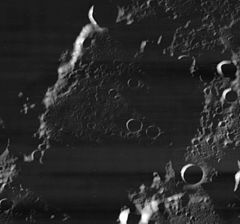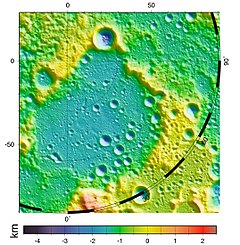Peary (crater)
Colongitude 25° at sunrise | | |
| Eponym | Robert Peary | |
|---|---|---|


Peary is the closest large lunar impact crater to the lunar north pole. At this latitude the crater interior receives little sunlight, and portions of the southernmost region of the crater floor remain permanently cloaked in shadow. From the Earth the crater appears on the northern lunar limb, and is seen from the side.
Observation and Etymology
Since Peary is located nearly on the limb of the Moon as viewed from Earth, high-quality images of the crater were not available until space probes started photographing the Moon; the first high-quality images came from the US
Physical features
Peary is nearly circular, with an outward bulge along the northeast rim. There is a gap in the southwestern rim, where it joins the slightly smaller crater
Because of the low sun angle, the average temperature on the crater floor or Peary is between 30 and 40 K, one of the coldest locations in the Solar System.[3]
Illumination
In 2004, a team led by Dr
The northern rim of Peary is considered a likely site for a future
References
- ^ Lunar Orbiter 4, NSSDCA/COSPAR ID: 1967-041A, NSSDC archive, NASA.
- ^ Blue, Jennifer (July 25, 2007). "Peary". Gazetteer of Planetary Nomenclature, USGS. Retrieved 2014-12-08.
- ^ "Ten Cool Things Seen in the First Year of LRO", NASA Goddard Space Center, June 23, 2010. Retrieved 22 May 2018.
- ^ McKee, Maggie (April 13, 2005). "Sunny spot picked out for future lunar base". New Scientist. Retrieved 2007-09-11.
- ^ Emerson J. Speyerer and Mark S. Robinson, "Persistently illuminated regions at the lunar poles: Ideal sites for future exploration", Icarus Vol. 222, No. 1, January 2013, pp. 122-136 https://doi.org/10.1016/j.icarus.2012.10.010 . Retrieved 21 May 2018.
- ^ Researchers find ideal spot for moon base, CNN, April 18, 2005 (accessed 2010 August 22)
- ^ P. Gläser, J. Oberst, G.A. Neumann, E. Mazarico, E.J. Speyerer, and M.S. Robinson, "Illumination conditions at the lunar poles: Implications for future exploration", Planetary and Space Science, 2017. https://doi.org/10.1016/j.pss.2017.07.006
- Andersson, L. E.; Whitaker, E. A. (1982). NASA Catalogue of Lunar Nomenclature. NASA RP-1097.
- ISBN 978-0-521-81528-4.
- Cocks, Elijah E.; Cocks, Josiah C. (1995). Who's Who on the Moon: A Biographical Dictionary of Lunar Nomenclature. Tudor Publishers. ISBN 978-0-936389-27-1.
- McDowell, Jonathan (July 15, 2007). "Lunar Nomenclature". Jonathan's Space Report. Retrieved 2007-10-24.
- Menzel, D. H.; Minnaert, M.; Levin, B.; Dollfus, A.; Bell, B. (1971). "Report on Lunar Nomenclature by the Working Group of Commission 17 of the IAU". Space Science Reviews. 12 (2): 136–186. S2CID 122125855.
- ISBN 978-0-304-35469-6.
- Price, Fred W. (1988). The Moon Observer's Handbook. Cambridge University Press. ISBN 978-0-521-33500-3.
- ISBN 978-0-913135-17-4.
- ISBN 978-0-486-20917-3.
- ISBN 978-0-521-54414-6.
- Wlasuk, Peter T. (2000). Observing the Moon. Springer. ISBN 978-1-85233-193-1.
External links
- LAC-1 area - Map of northern lunar pole

